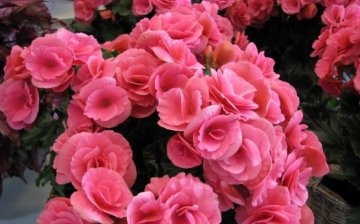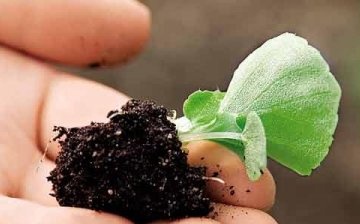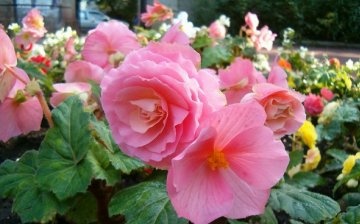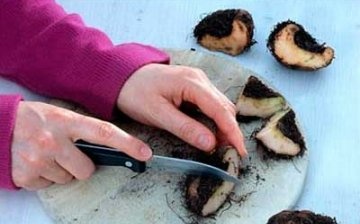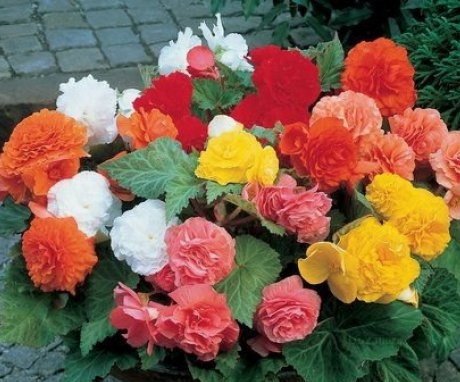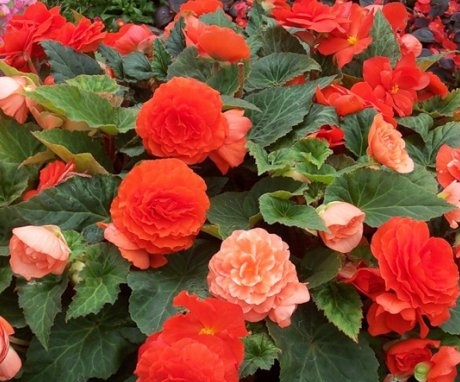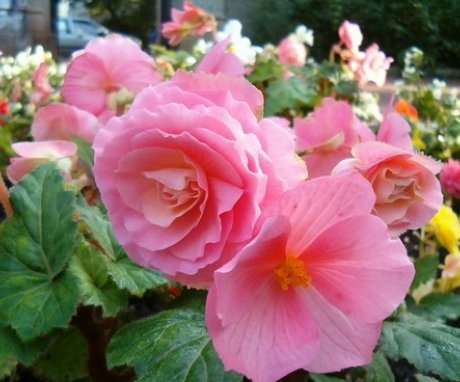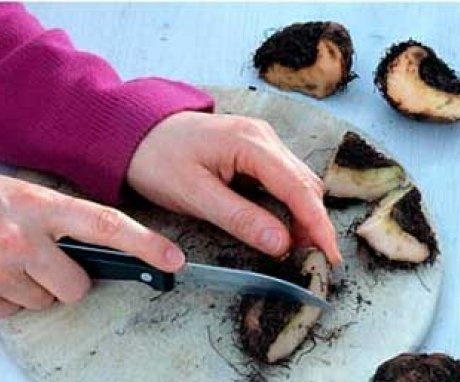Garden begonia - structural features, planting and care
Begonia garden is an ornamental plant, which is characterized by a high level of popularity among many gardeners. Flowers can be grown not only in the open, but also in greenhouses. Garden begonia characterized by ease of cultivation, which allows even an inexperienced grower to easily perform this action.
Content:
- Description of begonia
- Planting seedlings of garden begonia in the ground
- Features of plant care
- Plant care in the autumn-winter period
- Features of growing garden begonia from tubers
Description of begonia
Begonia can be both a perennial and an annual plant, which belong to the Begoniev family. This plant is characterized by the presence of a huge number of species. Garden begonia can be grass, shrub or shrub. This plant is characterized by the presence of asymmetric patterns that can have different colors.
Garden begonia loves shaded and draft-protected places. It has a beautiful and varied flowering period. This plant is capable of blooming for a fairly long time, which gives it special value.
Garden begonia is characterized by the presence of small flowers that have from 20 petals.
The color of the flowers of this plant can be orange, yellow, red, white, purple, etc. It is characterized by lush flowering, as one bush can have more than 10 flowers at the same time. Garden begonia is a very beautiful plant that can be used to decorate any landscape design. Care behind this plant, even an inexperienced gardener can do it.
Planting seedlings of garden begonia in the ground
Reproduction garden begonia is produced in two ways:
- Tubers
- Seeds
Before planting this plant, it is necessary to correctly select the location. Garden begonia must be protected from direct sunlight. That is why, for its landing, preference is given to shaded places. Despite the fact that the shade has a beneficial effect on the growth and development of begonias, it can be planted in sunny places.
This plant is planted in the first summer month. For planting in the ground, it must be used seedling... It can be purchased from a specialty store or grown by hand. If you decide to grow yourself seedlings garden begonias, then this issue needs to be addressed in winter.
Secrets of growing seedlings of garden begonia:
- Seedlings are planted in boxes, pots or plastic cups.
- It is necessary to put drainage on the bottom of the dishes, and cover it with fertile soil on top.
- Close up the seeds into the ground you need no more than one centimeter. This will ensure that healthy plants emerge quickly.
- Seedlings are covered with foil and placed in a warm place.
- The film must be periodically opened to saturate the soil with air.
- Seedling care consists in timely watering. It is necessary to perform this action as the earth dries up.
To ensure rapid flowering during the planting of begonias, seedlings are used, which are characterized by the presence of buds. For the fastest possible plant survival, it is made fertilizer... For this purpose, the most commonly used peat, which consists of potassium and phosphorus.
After planting the plant, the soil is regularly loosened, which allows not only to get rid of weeds, but also to ensure full growth and development of the garden begonia.
Disembarkation garden begonia is made quite simply. It is a fairly unpretentious plant, which allows you not to worry about the level of its survival rate.
Features of plant care
Garden begonia requires timely and high-quality care. This will allow her to provide gorgeous flowering. This plant needs regular feeding. For this purpose, the most commonly used are:
- Mineral fertilizers
- Peat
- Compost
Fertilizer garden begonias are produced by one of these types of fertilizers. When used in parallel, you can harm this plant. The root system of a garden begonia needs good air supply. This requirement is met by loosening the soil.
This plant loves moisture very much, therefore it is necessary to produce it in a timely manner. watering... Since garden begonia is grown mainly in the open field, the frequency of its watering directly depends on the weather conditions. If there is no rain in the summer, and the temperature is high, then it is necessary to water the plant every few days.
It is necessary to water the garden begonia in the evening after sunset or in the morning before sunrise.
When watering this plant, you must ensure that there is no stagnation of water. Otherwise, the roots of this plant can rot, which will lead to its death. In order to avoid the consequences of excessive watering during planting of garden begonia, it is necessary to use drainage not only in pots, but also in the open field. Watering the plant must be produced in such a way that water does not fall on its leaves. Otherwise, brown spots may appear on them, which negatively affect the decorativeness of the plant. In the autumn, it is necessary to stop watering the tubers. begonias.
Plant care in the autumn-winter period
At the beginning of autumn, the tubers of this plant are dug up. Initially you need:
- Cut the stems of the garden begonia so that 5-7 centimeters are left above the ground. For this purpose, flower growers use garden shears.
- After digging up the tubers, they must be dried indoors for 15-20 days.
- Next, you need to shake off the remnants of the earth and stems from the roots of this plant.
- The tubers of this plant must be placed in pots or any other container that is pre-filled with sand.
- The tubers are placed in a cool place. It is best to store the tubers of this plant in the basement or in the refrigerator. In this state, it is necessary to save the tubers. begonias garden before spring.
Tuber germination is carried out in the spring. For this, a small box is used. Sand is poured into it, which must be pre-moistened. The tubers of this plant must be placed in the box. At the same time, it is strictly forbidden to deepen them. When the first shoots appear, the tubers are cut so that at least one bud remains on them.
In order for the healing of the sections to occur as quickly as possible, they must be sprinkled with charcoal, which is finely crushed beforehand.
It is necessary to dry the sections within two hours. After adding the slices, the tubers are planted in pots so that the growing point is located on the surface. After seedling grows up, it must be planted in the ground.
Garden begonia needs not only summer, but also winter care. The growth and appearance of this plant directly depends on the quality of this care.
Features of growing garden begonia from tubers
You can grow this plant from seed, but this is a rather lengthy and complicated procedure. This is why tubers are best used. You can also propagate this plant using the method cuttings... In winter, tubers should be stored in special bags, which are pre-filled with peat. The choice of a storage place for tubers must be taken as responsibly as possible. It must be dark and cool without fail.
Reproduction of begonias by tubers:
- After pulling the tubers out in February, it is necessary to soak in a solution of zircon, which has a positive effect on the awakening of this plant.
- Further, the tubers must be placed in pots, which are characterized by the presence of a minimum amount of soil.
- Watering soil during the germination of the tubers of a given plant is produced only along its edges. Garden begonia loves moisture very much, but it is not worth overmoistening the soil.
The simplest method of growing garden begonia is to use tubers.
Even an inexperienced gardener will be able to grow this plant in this way. Any grower can grow a beautiful and attractive begonia. To do this, you just need to follow certain rules.
More information can be found in the video.



